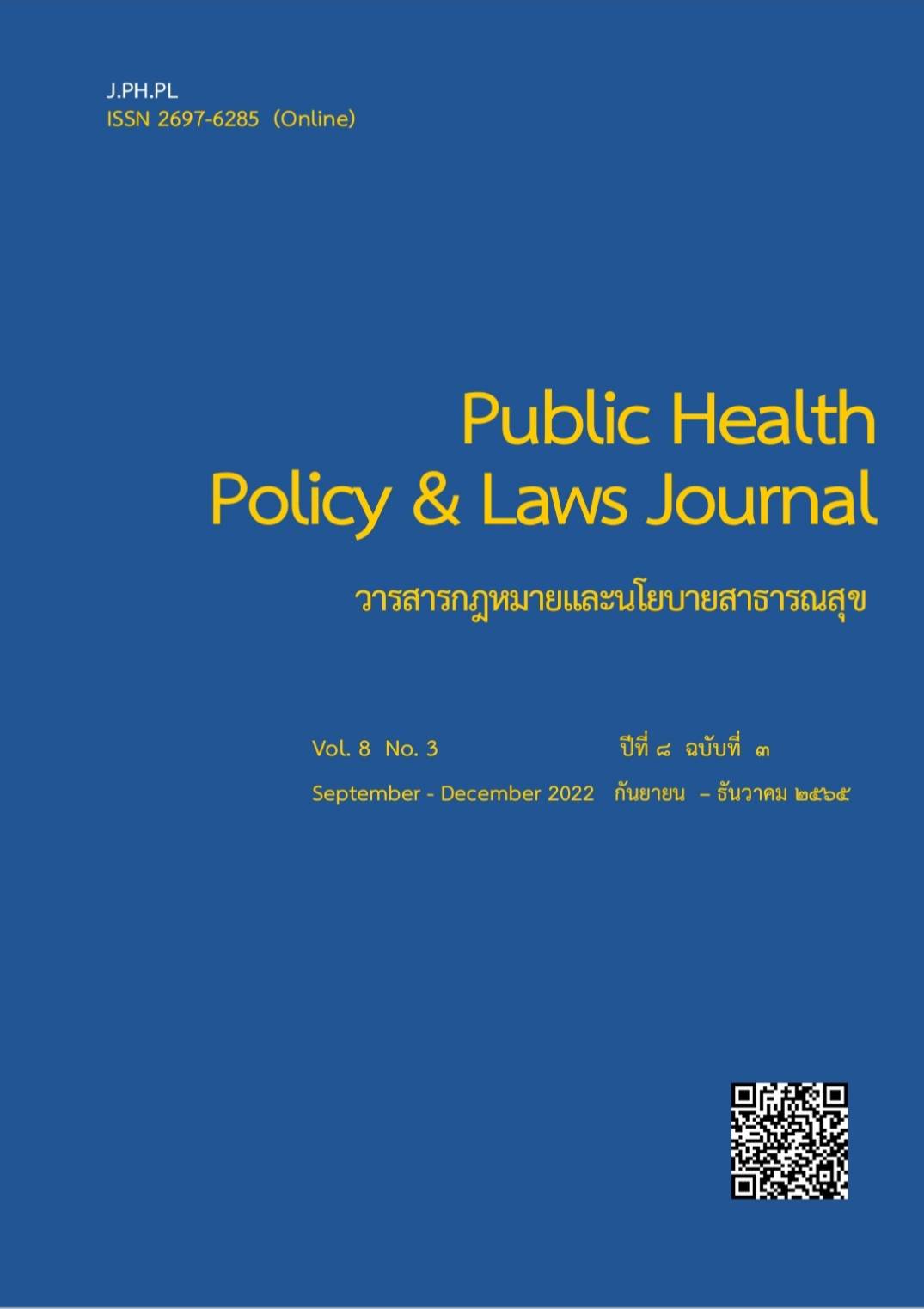Clinical risk management for medical for medical personnel in Chumphon Khet Udomsakdi Hospital
Keywords:
Clinical Risk Management, HFACS, Organization InfluencesAbstract
The objective of this research was to measure the level of clinical risk management and study factors related to clinical risk management of medical personnel in Chumphon Khet Udomsakdi hospital. The samples consisted of 260 medical personnel, who directly provide medical services. Self-administered questionnaire is used for data collection. The content validity was explored by 3 experts. The reliabilities test using the Cronbach’s alpha coefficients in parts 2 and 3 were 0.805 and 0.957 respectively. Data were analyzed by the frequency, percentage, average, standard deviation and Pearson’s correlation test.
The results revealed that. The Most of the sample were female (94.2%), aged between 22-30 years (57.7%), registered nurses (86.2%), bachelor's degree (96.20%), working hours 41-50 hours/week (36.20%), and the working period in hospital between 3-5 years (35.8%). The Overall clinical risk management of medical personnel was high level ( =3.57, S.D.=0.63). The correlation analysis found that the unsafe act, unsafe supervision and organization influence, there was a correlation with clinical risk management with statistically significant (r= - 0.906, r = 0.682 and r = 0.430 (p < 0.05)) respectively.
Therefore, personnel should be encouraged to risks identification proactively from operations and study and learn about risk incidents from other unit to analyze the severity, frequency and potential loss. The executive important to the clinical risk management system, by assigning persons with roles to control, supervise, monitor and determine measures to prevent unsafe act of medical personnel.
References
กิตติธร ปานเทศ. (2561). โรคที่เกิดจากการรับบริการสาธารณสุขและการไกล่เกลี่ยข้อพิพาท. วารสารกฎหมายสุขภาพและสาธารณสุข, 4 (1) มกราคม–เมษายน; 108-119.
จีรนันท์ ชานนท์, ประจักร บัวผัน. (2564). ปัจจัยแห่งความสำเร็จและวัฒนธรรมความปลอดภัยขององค์การที่มีผลต่อการบริหารความเสี่ยงของพยาบาลวิชาชีพที่ปฏิบัติงานในหอผู้ป่วย โรงพยาบาลขอนแก่น. วารสารวิจัย มข. (ฉบับบัณฑิตศึกษา), 21 (1) มกราคม-มีนาคม; 216-228.
จีรวรรณ์ ศิริมนตรี และ วรรณชนก จันทชุม. (2564). ความสัมพันธ์เชิงเหตุผลระหว่างการนิเทศทางคลินิก การบริหารความเสี่ยง และผลลัพธ์ทางการพยาบาลตามการรับรู้ของพยาบาลวิชาชีพปฏิบัติงานในหอผู้ป่วยหนัก โรงพยาบาลตติยภูมิภาคตะวันออกเฉียงเหนือ. วารสาร โรงพยาบาลสกลนคร, 24 (2) พฤษภาคม – สิงหาคม 2564; 1-12
โรงพยาบาลชุมพรเขตรอุดมศักดิ์. (2564). ระบบความเสี่ยง. เข้าถึงเมื่อวันที่ 1 สิงหาคม 2564. https://www.chumphonhospital.com
เพชรสุนีย์ ทั้งเจริญกุล. (2561). การจัดการเชิงระบบเพื่อให้เกิดความปลอดภัยของผู้ป่วย. พยาบาลสาร มหาวิทยาลัยเชียงใหม่ , 45 (2), เมษายน-มิถุนายน; 148-156.
วิไลลักษณ์ วิสาสะ. (2564). ผลการดำเนินงานในสำนักงานหลักประกันสุขภาพแห่งชาติ (สปสช.). ใน: เอกสารประกอบการบรรยายผลการดำเนินงานของสำนักงานหลักประกันสุขภาพแห่งชาติ. การประชุมศึกษาดูงานออนไลน์ของนักศึกษาหลักสูตรวิทยาศาสตรมหาบัณฑิต ภาควิชาบริหารงานสาธารณสุข(ภาคพิเศษ) มหาวิทยาลัยมหิดล.
อนุวัฒน์ ศุภชุติกุล. (2564). การเรียนรู้จากอุบัติการณ์ Learning from Incidents HA tool and quality in diversity update. ใน: เอกสารประชุมวิชาการ HA
National Forum 21 (Enhancing TRUST in Healthcare); วันที่ 17 มีนาคม 2564; กรุงเทพฯ.
Donabedian A. (1988). The quality of care: How can it be assessed? Journal of the American Medical Association, 260(12), 1743–1748.
Shale S. and Woodier N. (2021). Human Factors Analysis and Classification System (HFACS) Coding framework adapted for the NHS Acute Hospital setting (v4.2) (Internet). Norfolk and Norwich University Hospitals, NHS Foundation Trust; 2020-2021. https://www.nnuh.nhs.uk/publication/download/human-factors-classification-system-serious-incidents-2020-2021-20-21
Shappell SA, Wiegmann DA. (2000). The human factors analysis and classification system-HFACS (Internet). (Cite 2021 Sep 22). https://www.researchgate.net/ publication/247897525 The_Human_ Factors Analysis_and_Classification_System-HFACS
Weiers, Ronald M. (2005). Introduction to Business Statistics. International Student Edition. Fifth Edition. Pennsylvania, USA. Duxbury Press, Thomson - Brooks/cole
Wilson J. & Tingle J. (1999). Clinical risk modification: A route to clinical governance, Oxford: Butterworth-Heinemann.
World Health Organization. (2019). Patient safety fact file: patient safety and risk management service delivery and safety. Geneva: [Internet]. World Health Organization. Retrieved Sep 16, 2021. https://www.who.int/features/ fact files/patient safety/patient-safety-fact-file.pdf
World Health Organization. (2009). Conceptual framework for the international classification for patient safety, version 1.1: final technical report January 2009. https://www.who.int/patientsafety/taxonomy/icps_full_report.pdf
Downloads
Published
How to Cite
Issue
Section
License
Disclaimer and Copyright Notice
The content and information presented in articles published in the Journal of Law and Public Health Policy represent the opinions and sole responsibility of the respective authors. The editorial board does not necessarily agree with or assume any responsibility for the views expressed.
All articles, data, content, images, and other materials published in the Journal of Law and Public Health Policy are the intellectual property of the journal. Any individual or organization wishing to reproduce, distribute, or otherwise use the entirety or any part of such materials must provide proper citation.





